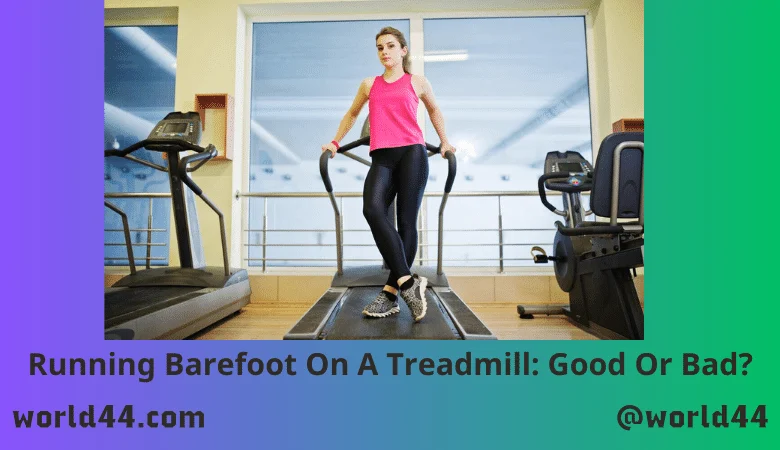Running Barefoot On A Treadmill: Good Or Bad?

A new trend around the world is running on a treadmill without shoes. Running barefoot on the treadmill is something you’ve thought about doing as well. You may have tried it while running outside in the morning. With a few changes to how you run and some careful things to consider, you can enjoy a barefoot run while keeping your safety in mind.
Running barefoot on a treadmill may make your lower legs swollen, blistered, or strained. Watch out for foot injuries, change the speed and incline, and change how you run. These essential running tips may help barefoot treadmill runners stay healthy and avoid getting hurt.
Benefits Of Running Barefoot On A Treadmill
Many people are interested in running on a treadmill barefoot, so let’s start by listing the pros. It helps you keep your balance because it brings you closer to nature and strengthens your muscles and walking. When you run outside, you often have to worry about rocks, glass, and dust, but when you run on a treadmill, you don’t have to. As barefoot treadmill running benefits, here are a few reasons to run on a treadmill without shoes:
Building Up Muscles
When you put your feet on the ground without running shoes, your muscles work harder and strain. The Achilles tendon, calf muscles, and other foot ligaments are stretched and worked out, which gives the tissues a lot of support. Running on a treadmill without shoes can help you build muscle without putting too much stress on your joints. Because of this, the muscles and joints in the knee are less likely to get hurt or damaged.
Smooth And Efficient Operation
Remember that running on a treadmill barefoot will take some time to get good at. When you don’t have shoes, you naturally land on your midsole and the balls of your feet instead of your heels. Your heel should take shorter steps on the treadmill and land softly.
This keeps you running smoothly and continuously. When you work out, you can improve your endurance and stamina because the front of your foot arches naturally to absorb shock. In addition, strength and impulses get much better because less oxygen is used than running with shoes on.
Proprioception And Balance
With each step, your feet will hit the treadmill belt, making you more aware of how to keep your balance and posture. Your body is better supported as your feet get bigger to hold your weight and help your legs move.
Since this type of running focuses on the muscles and doesn’t stress the joints or heel, it improves coordination, stability, and balance in the mind. Because of this, running barefoot on a treadmill keeps your running style natural and primitive by making your steps lighter and more efficient.
Drawbacks Of Running Barefoot On A Treadmill
Running barefoot is like a picture, it has two sides. Many people’s feet aren’t naturally used to running barefoot, so the muscles may feel tight, and blisters may appear at first. You’re more likely to get hurt or worn down because your feet constantly rub against the treadmill belt. There is also less room for your feet.
A treadmill runner may not want to run barefoot because the soles of their feet can get worn down, and they may feel unwanted impacts. Another reason it might be wrong is that the feet don’t have a protective layer, and running on a treadmill barefoot could damage legs or hurt feet. Here are some reasons why people don’t like the idea of running barefoot:
Sole Abrasion:
If you’re not careful, your feet could get hurt if they come into contact with the ground or the treadmill belt. Since running shoes protect your feet, running barefoot can cause cuts, scrapes, or burns on your feet from the constant friction. The soft bottom of the foot isn’t used to running like this so it can wear down with each step.
Treadmill Problems:
Along with the sudden changes in how you run, a treadmill belt has some big problems you can’t ignore. If you run on the ground, the impact moves your body forward through your feet. On a treadmill, on the other hand, the belt throws itself at you and forces the impact through your feet. Another problem with treadmills is that they make the space feel small since you have to take shorter steps to keep your feet from touching the plastic or shifting away from the belt.
You also remove a protective layer on your feet when you remove your shoes. And while treadmill belts have excellent grip and traction, they get very hot quickly and burn your feet on the bottom. The good news is that you can avoid these treadmill injuries by changing how you walk.
Hurt Feet And Damaged Muscles:
A smooth belt surface is helpful because it keeps your feet safe from rocks and dirt, but running on a flat surface repeatedly works the same muscles because the ground’s height, medium, or angle doesn’t change.
When you run barefoot, you put more stress on the muscles in your soles without working out your heels. This makes the muscles and tendons stiff from too much use. If you don’t have a heel lift, you should know about Achilles tendonitis, plantar fasciitis, and calf tendinitis.
Conclusion
There is a different environment for running on a treadmill, so if you want to run naturally, you should start slowly until your feet get used to the belt. If you read the machine’s instructions, you should stop running barefoot if your foot gets hurt or rough. Before you try this, you should talk to your doctor if you have a history of foot injuries or certain medical conditions.




